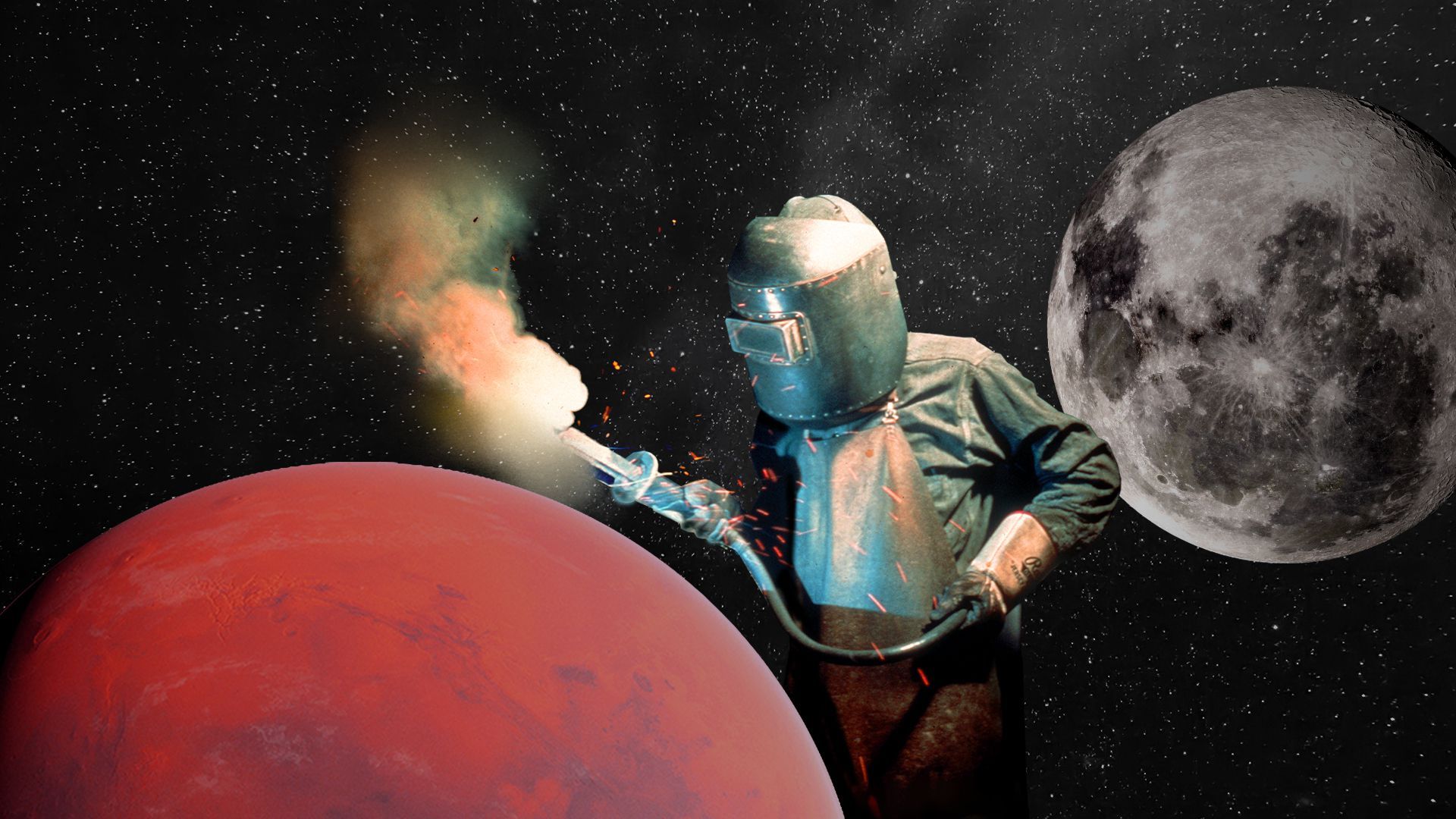| | | | | | | Presented By Stanford Medicine | | | | Axios Future | | By Bryan Walsh ·Sep 08, 2021 | | Welcome to Axios Future, where my editors have told me to keep the intros sho— Today's Smart Brevity count: 1,514 words or about 6 minutes. | | | | | | 1 big thing: Mining data to mine battery metals |  | | | Illustration: Aïda Amer/Axios | | | | A startup is using artificial intelligence to find new sources of metals that power electric vehicles and renewable energy technologies. Why it matters: The world desperately needs new supplies of lithium, cobalt and other metals to accelerate the shift to EVs and renewable energy, and machine learning can help narrow the search. Driving the news: This morning, the Silicon Valley-based startup KoBold Metals — which is backed by Bill Gates and Jeff Bezos, among others — announced a partnership with the world's largest mining company, BHP Group, to use its technology to locate battery metal deposits. - The partnership will focus on a more than 193,000-square-mile area of Western Australia, a region KoBold CEO Kurt House notes is "bigger than California."
- The search will focus on copper and nickel deposits believed buried 650–5,000 feet below the surface.
The big picture: "We need roughly $10 trillion worth of new discoveries of lithium, nickel, cobalt, copper and rare earth minerals just to be able to fully electrify the world's passenger vehicle fleet," says House. - "But exploration success rates have been declining in recent years because the easy surface deposits have been found and because there just hasn't been a lot of investment in exploration technology," he adds.
How it works: Conventional mining exploration involves collecting physical deposits from field sites and analyzing them, but that takes time, with plenty of false starts. By one assessment, only 1 in 100 sites will have a deposit that can be profitably mined, and that proportion has been dropping in recent years. - KoBold argues it can boost discovery rates 20-fold by tapping 160 years' worth of scattered geological data, as well as new data taken from fresh surface readings, and using machine learning approaches to analyze it and indicate where mineable deposits are likely to be found underground.
- "This is fundamentally an information problem with a search problem that's perfectly set up for the kind of advanced scientific computing that has had minimal investment up to this point," says House.
Between the lines: BHP's partnership with KoBold is part of the mining giant's effort to build out its portfolio of what it calls the "future-facing commodities" that will run the renewable-energy economy. - Anglo-Australian mining company Rio Tinto has increasingly tapped artificial intelligence as part of its exploration process in recent years, including one major copper find in Western Australia.
- Such efforts need to speed up. A May report by the International Energy Agency found that deploying enough clean technologies to prevent 2°C of warming would increase demand for energy-storage minerals more than 30-fold by 2040.
Read the rest |     | | | | | | 2. COVID didn't lead to a pandemic of hunger in the U.S. |  Data: U.S. Department of Agriculture; Chart: Axios Visuals New data shows rates of hunger among U.S. households didn't spike in 2020, despite the effects of the pandemic. The big picture: Economic downturns as sharp as the one experienced during the worst of COVID-19 last year usually result in devastating spikes in hunger. 1 in 10 households are still food insecure, but massive increases in aid helped avert much worse. By the numbers: According to a report released today by the USDA, 10.5% of U.S. households reported some level of food insecurity in 2020 — the same percentage as in 2019. - The percentage of households that reported very low food security — meaning they worry food will run out before they get money to buy more — actually declined from 4.1% in 2019 to 3.9% in 2020.
Flashback: That's not how the situation looked through much of 2020, when the sudden loss of 20 million jobs caused by the pandemic led to major stress on food banks throughout the U.S. - During the Great Recession in 2008, food insecurity spiked sharply from 11.1% to 14.6% of U.S. households, and it didn't dip below 14% until 2015.
What they're saying: "This is huge news — it shows you much of a buffer we had from an expanded safety net," Elaine Waxman, who researches hunger at the Urban Institute in Washington, told the New York Times. Read the rest. |     | | | | | | 3. A massive regional gap is opening around AI |  | | | Illustration: Aïda Amer/Axios | | | | A handful of superstar U.S. metro areas are leading the way in AI, while much of the rest of the country is at risk of being left behind. Why it matters: AI can enhance productivity and growth in multiple sectors, but as a technology that tends to centralize around a handful of talent hubs, it could also increase regional economic disparity across the country. What's happening: In a new report released today, researchers at the Brookings Institution assessed the geographic distribution of AI talent, investment and research around the U.S. - It shouldn't be surprising that the Bay Area — including both San Francisco and San Jose — was far and away the leader, accounting for one-quarter of AI conference papers, patents and companies.
- Add in another 13 "early adopter" cities — including New York, Austin and Seattle — and these 15 metro areas account for two-thirds of the nation's AI assets and capabilities.
The other side: More than half of the 261 U.S. metro areas surveyed by Brookings exhibit no significant AI activities at all. What they're saying: "AI is at the stage where it is highly dependent on a super-specific talent base, and there's also a heavy need for massive computing power," says Mark Muro, policy director at Brookings' Metropolitan Policy Program and a co-author of the report. - "Those resources aren't available everywhere," he adds.
Read the rest. |     | | | | | | A message from Stanford Medicine | | Learning from the global response to COVID-19 | | |  | | | | Join Stanford Medicine and Stanford Graduate School of Business for The Pandemic Puzzle: Lessons from COVID-19, a free, virtual series bringing together experts across health care, business, and government to discuss the global response to COVID-19. Register for free. | | | | | | 4. The final frontier opens for business |  | | | Photo illustration: Annelise Capossela. Photo: Alfred T. Palmer/Getty Images | | | | A drastic reduction in launch costs is helping fuel a vision of space not just as a realm of exploration or science, but real industry. The big picture: Over the short term, space will likely become a place to manufacture high-precision, high-value products that benefit from a microgravity environment. But in the future, as Jeff Bezos noted in July after returning from his space trip, there could be a push to move heavy, polluting industries to operate in space. By the numbers: Space startups brought in a record $7.6 billion in investment last year, and a July report from Space Capital found $9.9 billion was invested in all space companies in the second quarter of 2021 alone. - "We're in the second golden age of space, and it's going to be a sustained golden age, because it's not just driven by government activity but commercial activity," says Andrew Rush, the COO and president of the aerospace company Redwire.
Background: Space enthusiasts have long dreamed of not just exploring space, but building there too. But the sheer cost of moving material and people into orbit kept those dreams in the realm of science fiction. - Thanks largely to the efforts of private companies like SpaceX and Blue Origin, the cost of launching payloads into orbit has fallen drastically over the past decade, opening up space to smaller players that were previously locked out of the industry.
- "As it's getting cheaper and cheaper per kilogram to launch into space, it makes logical sense for super high value, very expensive things per kilogram to be made in space and brought back down to Earth," says Josh Wolfe, co-founder of the VC firm Lux Capital, which has invested in multiple space startups.
Read the rest. |     | | | | | | 5. Worthy of your time | | Companies need more workers. Why do they reject millions of résumés? (Kathryn Dill — Wall Street Journal) - The algorithms companies use to screen applicants could be unfairly eliminating millions of potential workers.
Can progressives be convinced that genetics matter? (Gideon Lewis-Kraus — New Yorker) - A fascinating profile of the behavior geneticist Kathryn Paige Harden, whose new book reckons with the effect that new genetics discoveries could have on politics.
Research on solar climate intervention is the best defense against moral hazard (Daniel Bodansky and Andy Parker — Issues in Science and Technology) - Opposing research into solar geoengineering could backfire if the technology ends up being used without testing.
Does risk tolerance change through the week? (Rob Jenkins — The British Academy) - Yes — and if you're feeling risky, just wait for Friday.
|     | | | | | | 6. 1 fun thing: History's worst takes |  | | | The beloved Smithsonian Institution, which someone apparently thought was a terrible idea. Photo: Archive Photos/Getty Images | | | | A long-buried government report rounds up some of history's worst predictions. Why it matters: Take it from someone who writes a newsletter about the future — it's hard to predict. - But studying why experts made erroneous predictions might help improve our batting average.
What's happening: Produced in the mid-1960s by the Legislative Research Service — the precursor to what is now the Congressional Research Service — the 48-page report was known internally as "The Erroneous Predictions Multilith," reports John Kelly in the Washington Post. - Compiled by researcher Nancy T. Gamarra, it includes more than 20 truly terrible predictions throughout history, mostly about exploration and technological development.
Some of the doozies include: - A 1486 royal committee that advised King Ferdinand and Queen Isabella not to fund Columbus' expedition because "it was unlikely anyone could find hitherto unknown lands of any value."
- Sen. Simon Cameron complaining in 1861 that the Smithsonian Institution wasn't worth funding because "I am tired of all this thing called science here."
- Adm. William Leahy telling President Truman in 1945 that the atomic bomb "will never go off, and I speak as an expert in explosives."
The bottom line: Think of this report as the 1960s equivalent of a series of Twitter quote-retweet dunks. |     | | | | | | A message from Stanford Medicine | | Free virtual series on the global response to COVID-19 | | |  | | | | Join Stanford Medicine and Stanford Graduate School of Business for The Pandemic Puzzle: Lessons from COVID-19, a free, virtual series bringing together experts across health care, business, and government to discuss the global response to COVID-19. Learn more and register. | | |  | | It'll help you deliver employee communications more effectively. | | | | | | Axios thanks our partners for supporting our newsletters. If you're interested in advertising, learn more here.
Sponsorship has no influence on editorial content. Axios, 3100 Clarendon Blvd, Suite 1300, Arlington VA 22201 | | | You received this email because you signed up for newsletters from Axios.
Change your preferences or unsubscribe here. | | | Was this email forwarded to you?
Sign up now to get Axios in your inbox. | | | | Follow Axios on social media:    | | | | | |









No comments:
Post a Comment